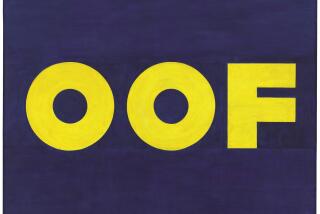Form and Fame of a ‘Forgotten Genius’
- Share via
Described by those who knew him as a forgotten genius with an eccentric personality, Stanislav Szukalski was his own biggest obstacle to artistic acclaim.
A Polish nationalist and staunch rebel, Szukalski protested Germany’s invasion of his homeland, fought art critics, curators and gallery owners and refused to join art movements that would have furthered his reputation but categorized his work.
For most of his life, he did not live as a career artist. Reluctant to sell his paintings and sculptures, he survived by drawing maps for a Southern California aerospace firm.
It’s no wonder that his first retrospective, “Struggle: The Art of Szukalski,” will be presented posthumously, opening Sunday at the Laguna Art Museum.
“Here is this artist who barked off everything he thought, and that offended a lot of people,” said Glenn Bray. He and his wife, Lena Zwalve, own the artist’s estate, and Bray is executor of Archives Szukalski, based in Los Angeles.
“He was his own worst enemy. It took me a while to realize that he would not be famous in his lifetime because of his brashness.”
Szukalski began his formal training at the Krakow Art Academy at the age of 14. Since the 1940s he lived in Burbank, where he died 13 years ago at 93. He was virtually unrecognized in the United States, even though he was highly regarded in Poland during his early career.
After he came to live permanently in the United States, he barely made enough money to pay rent, much less to rent a studio. Still, he created a large body of work.
The retrospective contains 52 bronzes, including life-size pieces, statuettes and commemorative medallions, and 157 works on paper, including Conte crayon drawings and scrapbook pages and sketchbooks filled with studies and illustrations. Black-and-white photographs--the only existing images of works destroyed in the second World War--and 26 handmade sculpting tools will also be displayed.
Those who admire his works say Szukalski fused the movement and energy of Futurism, the emotion of Impressionism and the geometric configurations of Cubism into a single, poetic form. His art reflects his studies in anthropology and mythology. He tried to draw connections between different cultures, particularly the Greeks, the Meso-Americans and his Polish heritage.
“Szukalski created these sculptures where the figures were crosses between animals and people, and he put these different cultural references into his artwork for this unifying theory of a better world,” said Tyler Stallings, curator of exhibitions at the Laguna Art Museum.
“His works have a sense of illustration. They’re like storybook drawings that allow people to understand the narrative of his pieces.”
A collector by nature, Bray stumbled upon Szukalski’s works in art books on the dusty shelves of a used bookstore. Little did he know that he and Szukalski lived in the same neighborhood. “Who would have thought that a famed Polish artist was living in your backyard?” Bray said.
The two became close friends.
Because Szukalski never had enough money to have his work cast in bronze--he made plaster molds only--Bray took on the task of having them properly cast.
During the ‘20s and ‘30s, his bronzes won him recognition from the Polish government, which honored him in 1936 with commissions for large works. Most of these were destroyed by the Nazis. He fled Poland in 1939.
His continual acts of rebellion only contributed to his obscurity, a situation his friends hope to remedy. One well-placed friend is George DiCaprio, an alternative comics artist who named his son after Leonardo da Vinci. The show is sponsored by the son, actor Leonardo DiCaprio, and his father, who befriended Szukalski through Bray. The DiCaprios are underwriting the exhibition at a cost of $12,500.
Through these admirers, Szukalski’s reputation continues to grow.
“It’s amazing that an artist of this caliber and talent could go unrecognized,” Stallings said. “I’d never heard of this artist, yet I’m blown away by the work. . . . It feels like discovering a secret treasure.”
*
* “Struggle: The Art of Szukalski” opens Sunday and ends Jan. 7. Hours: Daily, except Wednesdays and Monday holidays, 11 a.m.-5 p.m. $3-$8. Lecture by curator Tyler Stallings, Nov. 16, 7:30 p.m. Laguna Art Museum, 307 Cliff Drive, Laguna Beach. (949) 494-8971.
More to Read
The biggest entertainment stories
Get our big stories about Hollywood, film, television, music, arts, culture and more right in your inbox as soon as they publish.
You may occasionally receive promotional content from the Los Angeles Times.










